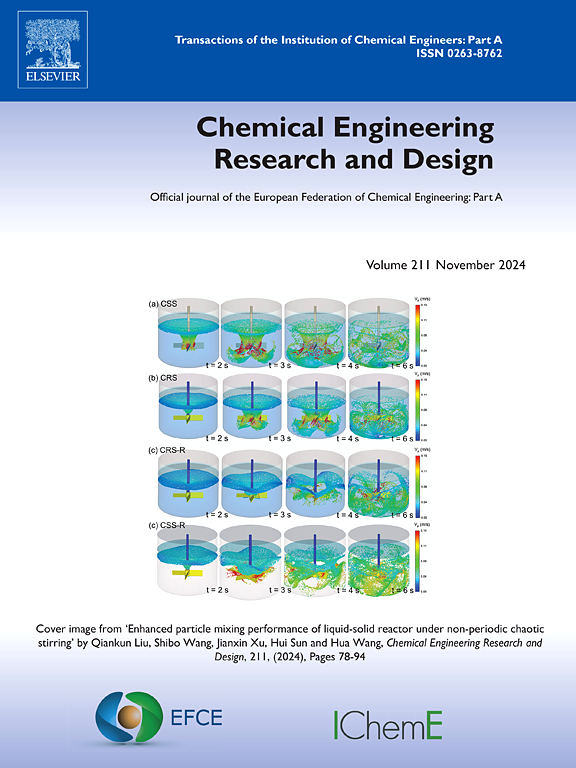使用聚合氯化铝和层压剂凝结去除聚乙烯微塑料
IF 3.7
3区 工程技术
Q2 ENGINEERING, CHEMICAL
引用次数: 0
摘要
作为水中新出现的污染物,微塑料对水生生物和人类健康构成潜在风险。以往的研究表明,传统的金属混凝剂能有效去除水中的微塑料,但也存在化学用量大和金属残留等缺点。因此,探索更高效的混凝系统非常重要。本研究利用层皮素(LA)作为助凝剂,并结合聚合氯化铝(PAC),研究其对水中聚乙烯微塑料的增强混凝性能。针对不同的助凝剂用量、pH 值、阴离子和 HA 含量,对混凝系统去除微塑料的性能进行了评估。实验结果表明,与单一 PAC 系统相比,复合系统(PAC-LA)显著提高了对聚乙烯微塑料的去除效率,在减少 PAC 用量的同时,去除率达到 91.5%。利用扫描电子显微镜(SEM)、傅立叶变换红外光谱(FTIR)、X 射线光电子能谱(XPS)和 zeta 电位分析等多种技术分析了 LA 的增强凝结机理。结果表明,在单独使用 PAC 的情况下,电荷中和与扫掠絮凝是主要的混凝机制。引入 LA 后,电荷中和与吸附作用得到加强。在不同的环境条件下(如不同的 pH 值、共存阴离子和腐殖酸),PAC-LA 混凝系统对 PE 微塑料的去除率更高,这表明其在水中微塑料控制方面具有广阔的应用前景。本文章由计算机程序翻译,如有差异,请以英文原文为准。
Coagulative removal of polyethylene microplastics using polyaluminum chloride in conjunction with laminarin
As emerging pollutants in water, microplastics pose potential risks to aquatic organisms and human health. Previous studies have shown that traditional metal coagulants are effective in removing microplastics from water, but they come with drawbacks such as high chemical dosage and metal residues. Therefore, it is important to explore more efficient coagulation systems. This study utilized laminarin (LA) as a coagulant aid in combination with polyaluminum chloride (PAC) to investigate its enhanced coagulation performance on polyethylene microplastics in water. The performance of coagulation systems for the removal of microplastics was evaluated for different agent dosages, pH, anion and HA content. Experimental results demonstrated that the compounded system (PAC-LA) significantly improved the removal efficiency of PE microplastics compared to the single PAC system, achieving a removal rate of 91.5 % while reducing the dosage of PAC. The enhanced coagulation mechanism of LA was analyzed using various techniques including scanning electron microscope (SEM), Fourier transform infrared spectroscopy (FTIR), X-ray photoelectron spectroscopy (XPS), and zeta potential analysis. The results indicated that charge neutralization and sweep flocculation were the primary coagulation mechanisms in the presence of PAC alone. The effect of charge neutralization and adsorption was strengthened with the introduction of LA. The coagulation system of PAC-LA showed higher removal rates of PE microplastics under different environmental conditions such as varying pH levels, co-existing anions, and humic acid, suggesting a promising application for microplastic control in water.
求助全文
通过发布文献求助,成功后即可免费获取论文全文。
去求助
来源期刊

Chemical Engineering Research & Design
工程技术-工程:化工
CiteScore
6.10
自引率
7.70%
发文量
623
审稿时长
42 days
期刊介绍:
ChERD aims to be the principal international journal for publication of high quality, original papers in chemical engineering.
Papers showing how research results can be used in chemical engineering design, and accounts of experimental or theoretical research work bringing new perspectives to established principles, highlighting unsolved problems or indicating directions for future research, are particularly welcome. Contributions that deal with new developments in plant or processes and that can be given quantitative expression are encouraged. The journal is especially interested in papers that extend the boundaries of traditional chemical engineering.
 求助内容:
求助内容: 应助结果提醒方式:
应助结果提醒方式:


